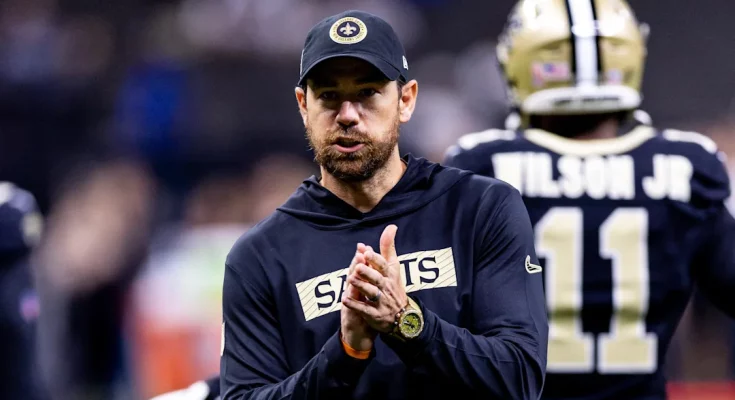When it comes to NFL offenses, much of the conversation in recent years has centered around superstar quarterbacks, dominant tight ends, and flashy running backs who can both run and catch the ball. Wide receivers, particularly those who are not headliners or fantasy football darlings, often get overlooked in the broader discussion of what makes a passing attack lethal. Yet in Seattle, offensive coordinator Klint Kubiak has been keen to shine a light on a facet of the Seahawks’ receiving corps that goes largely unnoticed by fans and even some analysts — their underrated quality that doesn’t always show up on the stat sheet but can swing games in subtle yet decisive ways. Kubiak, known for his football pedigree and keen eye for offensive nuances, has long been a coach who looks beyond the obvious. As the son of Super Bowl–winning head coach Gary Kubiak, he has been immersed in the sport for decades and understands the finer points of what makes a player or unit special. Speaking recently about the Seahawks’ wide receiver group, he made it clear that the talent and skill within this room run much deeper than what casual observers might see on Sundays. While many will instantly point to names like DK Metcalf, Tyler Lockett, and Jaxon Smith-Njigba and talk about speed, size, or route running, Kubiak pointed instead to something more intangible — the collective football intelligence, selflessness, and situational awareness that this group brings to the field. These are the kinds of qualities that don’t get as much media hype but are often the difference between an average offense and an elite one.
Kubiak noted that the Seahawks’ receivers excel in pre-snap recognition, adjusting routes based on defensive coverages, and reading the leverage of defensive backs to create space not just for themselves, but for their teammates. This is the kind of behind-the-scenes work that transforms a passing game from predictable to dynamic. In a league where defensive coordinators are constantly scheming to take away a team’s top weapon, having multiple receivers who can quickly process and adapt on the fly is invaluable. It keeps defenses guessing and allows quarterbacks to maintain rhythm even when the original play design is disrupted. Another aspect Kubiak praised was their commitment to blocking in the run game — a trait that often gets little attention from highlight reels but is crucial to the Seahawks’ offensive identity. Seattle has long been a team that thrives on a balanced attack, and their ability to run effectively opens up play-action opportunities downfield. For that to work, receivers need to sell their assignments in the blocking game, engaging defenders with the same intensity they bring to running routes. Kubiak pointed out that Seattle’s wideouts take pride in this physical element of their play, knowing that springing a running back for an extra ten yards can be just as impactful as making a tough catch in traffic.
Tyler Lockett, a veteran leader in the locker room, embodies this ethos. Known league-wide for his precise route running and dependable hands, Lockett has also built a reputation among coaches and teammates as one of the most fundamentally sound players in the NFL. His understanding of spacing, timing, and coverage nuances allows him to mentor younger receivers like Smith-Njigba, who entered the league with high expectations as a first-round draft pick. Metcalf, meanwhile, brings the physical dominance and explosiveness that make defensive coordinators lose sleep, but Kubiak emphasized that even he has embraced the cerebral and unselfish aspects of the position, often running decoy routes to pull coverage away from teammates or sealing off defenders on outside runs.
The combination of these individual skill sets and mindsets has given the Seahawks one of the most versatile receiving corps in the NFL. In Kubiak’s view, this versatility is a hidden weapon because it allows Seattle to morph its offensive identity week to week. Against a blitz-heavy defense, the receivers can adjust routes to give the quarterback quick outlets. Against a deep-zone team, they can work the intermediate areas methodically and break coverage discipline. And when the run game needs to be established to control the clock, they can turn into downfield enforcers, setting the edge and punishing defensive backs who are slow to shed blocks.
This adaptability also speaks to the trust and chemistry between the receivers and the quarterbacks. Whether it’s Geno Smith or another signal-caller, having a receiving corps that can anticipate adjustments without needing a lengthy sideline conference gives the offense a smoother, faster tempo. It’s one of the reasons Seattle’s offense has been able to maintain productivity even in games where the scripted plays didn’t go exactly as planned. That trust is built not only on repetition in practice but also on a shared understanding of the playbook’s core concepts.
Kubiak has worked with many talented receivers throughout his coaching career, but what stands out to him about Seattle’s group is their collective buy-in to the team concept. In an era when many receivers are judged primarily by personal stats and highlight plays, the Seahawks’ wideouts seem content to let their impact be measured in wins rather than box scores. This unselfishness can be infectious in a locker room and helps establish a culture where everyone pulls in the same direction. Kubiak also credited head coach Mike Macdonald for fostering that mindset across the team, emphasizing preparation, accountability, and execution over flash.
That’s not to say that Seattle’s receivers lack the ability to produce eye-popping plays. On the contrary, Metcalf’s breakaway speed and physicality, Lockett’s sideline toe-taps, and Smith-Njigba’s slippery yards-after-catch skills all make for thrilling highlights when the opportunities present themselves. But Kubiak’s point was that these moments are the tip of the iceberg — the result of countless small, often unseen contributions that set the stage for big gains. It’s a reminder that football, for all its explosive plays, is still a game of details. The teams that pay the most attention to those details often find themselves competing deep into January.
The timing of Kubiak’s praise may also be strategic. The NFC West remains one of the most competitive divisions in the NFL, with the San Francisco 49ers, Los Angeles Rams, and Arizona Cardinals all posing unique challenges. By highlighting the intelligence and adaptability of his receivers, Kubiak could be signaling that Seattle’s offense is prepared to counter whatever defensive wrinkles those teams might throw at them. In a division known for physical, fast, and creative defenses, having a receiver group that can think on its feet is a major asset.
In training camp, observers have already noticed how seamlessly the Seahawks’ passing attack flows during team drills. Routes are crisp, communication is clear, and receivers are consistently finding soft spots in coverage. While some of that can be attributed to quarterback play and coaching design, Kubiak’s comments suggest that the receivers’ mental approach is every bit as important as their physical execution. It’s a dynamic that could pay huge dividends once the regular season begins and defensive looks become more complex.
Ultimately, Klint Kubiak’s recognition of this “hidden weapon” within the Seahawks’ offense is a reminder that the game’s most valuable qualities are not always the most visible. Speed, strength, and spectacular catches are what draw fans’ eyes, but intelligence, discipline, and teamwork are what keep drives alive and win close games. If Seattle’s wide receivers continue to embrace and refine these underrated traits, they could very well tilt the balance of power in the NFC West — and perhaps beyond. In a sport where margins are razor-thin, those quiet advantages often speak the loudest when it matters most.
It’s easy to overlook the small things in football, especially when the league’s highlight culture pushes fans to focus on the spectacular. But for Kubiak and the Seahawks, those small things are the foundation on which big things are built. And if his evaluation is correct, Seattle’s receiving corps might just be the key to unlocking an offense capable of surprising a lot of people in the months ahead.



